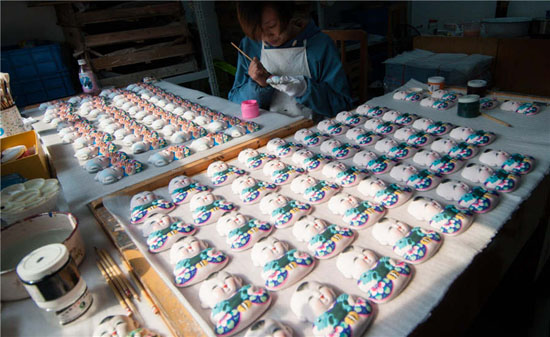 |
|
A craftsman paints clay figurines at the Huishan workshop in Wuxi, in Jiangsu province. [Photo/Xinhua]
|
A touch of color
A popular saying among figurine makers shows just how important this coloring is, as every figurine is seen as consisting of "30 percent molding and 70 percent color." This coloring is another feature that sets Huishan figurines apart from those made in Tianjin.
Usually after Yu finishes molding a piece by hand, the rest of the work is completed by her partner, coloring master Wang Nanxian. This coloring work can be especially difficult for some figurines, such as figures from traditional opera, as delicate coloring is used to underline facial expressions and the make-up used by these performers, as well as their costumes and small details like accessories.
These designs often have symbolic significance. For example, the clothing of Liu Mengmei - the hero of the Ming Dynasty play The Peony Pavilion, is covered with small plum flowers, a call back to his name - Mengmei (Dreaming of plums).
"Besides clothing, facial expressions are also important when it comes to conveying the characters' emotions, as well as the personality of the character from a play," said Wang.
"Eyes, eyebrows and lips are all key areas that show a character's temperament."
Whether it's the intoxicated Yang Guifei - one of the famous four beauties of ancient China and the imperial concubine of Emperor Tang Xuanzong - or the toadying Gao Lishi - a famous eunuch from the Tang Dynasty (618-907) - the touches added by Wang's brush help capture the spirit of the individual.
However, despite their high popularity, Huishan clay figurines face the same quandary that many other intangible cultural heritages face as well: a lack of experienced and talented individuals who can carry on this art form's legacy. According to a report by the Xinhua News Agency at the end of last year, the income for workers at a Huishan clay figurine workshop only amounts to 20,000 yuan ($3,240) per year.
Although the Wuxi government has established training classes to pass on this art form to students, only around half of students choose to work at a clay figurine workshop after graduation. This lack of motivation to pick up this ancient art, is also hindering the further development of this art, and makes it difficult to keep it from becoming a purely commercialized product.
We Recommend:
